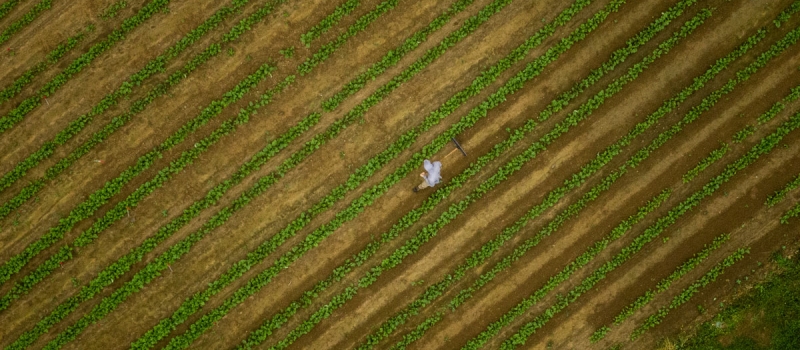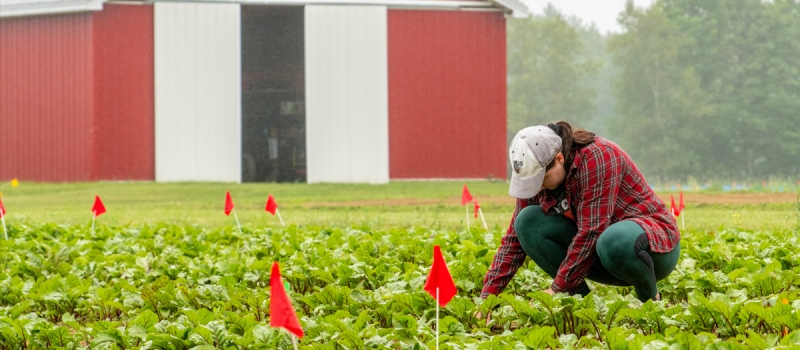B&W: SEPTEMBER FEATURE
THE WEED WHISPERER
UMaine’s Eric Gallandt looks to help small farmers with his ‘seed bank’ philosophy

WORDS /SAM PFEIFLE
As academics go, Eric Gallandt is something of a rare breed.
“Oh, most land-grant institutions — like here at the University of Maine — would have a weed scientist,” he says, “if not a couple. But in terms of the number of people who would call themselves ‘weed ecologists’? It’s probably on the order of 25 or so in this country.”
But Gallandt is working on that. As a professor of weed ecology at the University of Maine, he heads up the Weed Ecology and Management department, which offers students an opportunity to study weed management in a fundamentally different way from what is standard practice nowadays — and a way that may well be appealing to cannabis farmers who want to deliver healthy, organic product to the good people of Maine.
Essentially, weed ecologists study the ways of managing weeds via their very biology, the ways in which they interact with their environment — their ecology — rather than via herbicides or more recent efforts at genetic modifications.
You know: Big Agriculture and Roundup and the sorts of things communities all around the country are banning due to their deleterious effects on humanity.
He’s part of a growing portion of academia that’s looking to natural systems to solve agricultural problems, rather than toxic chemicals. Specifically, Gallandt works with small farmers in Maine to figure out new tools, new processes, and new strategies for managing weeds by understanding their very nature.
“My stakeholders are farmers,” he explains, “and I think of weeds as plants that are basically negatively affecting the yield or quality of the harvest they want to be growing. That’s to distinguish what I do from people who might study invasive plants in natural ecosystems, for example.”
He’s been at UMaine since 2000 and has spent much of his time working with the Maine Organic Farmers and Gardeners Association. And like MOFGA, he and his colleagues at UMaine — including John Jemison, who leads a one-credit class on cannabis production through the Cooperative Extension — have been increasingly interested in cannabis and helping farmers capitalize on it. They held a field day at Orono’s Rogers Farm not long ago, bringing together about a dozen cannabis growers to talk about ecological responses to weed growth and other topics.
For example, Gallandt is currently highly interested in what’s called “solarization.”
“It’s a process of working up some soil, and irrigating, and putting clear plastic over it, and creating a greenhouse effect,” Gallandt says. “It’s been used a lot in Mediterranean climates to reduce soil-borne diseases and weeds, and I didn’t think it would work here, but it turns out it works pretty well.”
Using clear plastic gets you warmer soil temperatures, but more farmers in Maine are using black plastic, often called “tarping,” which keeps the soil warm so the weeds germinate, but then die when the black plastic suffocates them. “Some small farms are having tremendous success creating the stale seed bed,” Gallandt says.

If you don’t re-till the soil after you remove the black tarp, the weeds in the upper layer of the soil aren’t able to germinate, because they’ve already germinated under the tarp, and as long as you don’t bring seeds to the top, you’ve eliminated much of your weed problem.
“It’s really good for small scale farms,” Gallandt says. “It hasn’t been scaled to date. I think it could be, if some people engineered some equipment to roll out plastic or fabric and then hold down the edges and then roll it back up and move it to another part of the farm. But that hasn’t happened.”
It’s part of a larger “seed bank” philosophy where instead of waiting for weeds to grow and then trying to kill them, you manage the seeds in the soil (or prevent them from getting there in the first place) and try to make sure the weeds never appear so you don’t have to pull them.
“Most seeds germinate here in the spring or summer,” Gallandt explains, “and then they produce an immature plant, then that reproduces, and then that mother plant’s seeds will typically fall down into the soil, which is basically the aim of the species: to have its genetics going forward in time.”
He calls that “seed rain.”
“You can go from one seed that produces a plant that produces hundreds of thousands of seeds,” he says, “so if you grow the seed in a competitive environment, if you manage the soil so that those seeds are spending as much time as possible at the soil surface, they’ll be more likely to be subject to predations — there are all kinds of animals that eat seeds, so-called seed predators — or the seeds on the surface will get cues to germinate and if they germinate at a bad time, the seedlings will likely die.”
Managing seed rain basically means screwing with the lifecyle.
“You need to think about the whole population and all of the life history transition,” says Gallandt, getting philosophical, indeed, “so it’s not just the seedling stage, which is what we usually think about. Most people think about pulling the weed, mulling the weed, or spraying the weed with a herbicide. That’s all important, but what about, ‘How do I encourage more of that weed to germinate so I can kill more seedlings?’ or, ‘How do I prevent that plant germinating in the first place?’”
Truly thinking of the seed bank means not just focusing on the weeds while you’re growing your crop. “If you reduce the density of those seedlings,” Gallandt explains, “you’ll maximize your harvest, but if you then let those weeds grow after you harvest your hemp crop, the few surviving weeds will get very large and they’ll provide a ton of seed and then you’ll replenish your weed seed bank and your problem will never get better.”
He also helps farmers with doing the math to figure out the return on investment that comes with managing the weed seed bank.
“You might think, ‘Okay, I don’t need to worry about these weeds because I’ve made my money,’ but post-harvest weed management is essentially a cost that will be budgeted for your future crops. If you start thinking about it from a longer-term perspective, then this philosophy ends up helping you come up with a strategy where weed management gets better over time, rather than just remaining the same.”
As small farmers are also small businesses, Gallandt’s research also looks at providing spreadsheeting tools and the like so farmers can document the value of their weed-reduction work.
In a time of seemingly increasing climate change, these sorts of calculations are as important — or more so — as watching out for new weeds that can survive in our Maine climate.
“This next week, for example, calls for misty rain,” Gallandt points out, something we typically don’t see in Maine summer. “If I have to go cultivate weeds, I’m basically out of luck. The fields are too wet.” Climate change has meant the past 15 years are the wettest summers on recent record.
“When I talk to farmers about climate change,” he says, “what I mostly talk about is the concept of field working days and what’s your likelihood of getting out into the field to do a management intervention when you really need to do it. Every day, weeds get bigger and harder to cultivate. … If today’s climate means we have a likelihood of getting in the field two days instead of four, which we would have been able to do 15 years ago, I might need equipment that covers twice as much ground in the same amount of time.”
More water, a longer growing season, higher temps — maybe these are things that make Maine a better place to grow. It’s hard to say. But it’s definitely possible that tried and true techniques for weed management may no longer work like they once did.
And that’s when farmers across the state will reach out to Eric Gallandt for help, once again.
Where can you find us in the wild?
+PUBLISHING SINCE 2021
BECAUSE TASTE MATTERS
With hundreds of breweries and retail cannabis exploding, there’s no need to put just anything in your body. Beer & Weed is about much more than a buzz. It’s about the best, smartest, most innovative brewers and growers and the people who enjoy their products. First Maine and New England, then the world. With your subscription, you’ll get access and insight into the hottest new releases, the best new ideas, and the latest developments in the production of beer and weed. Don’t miss out!


